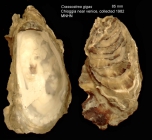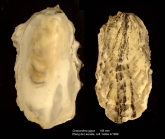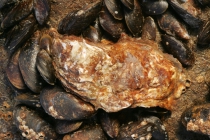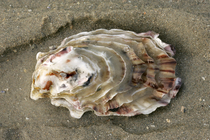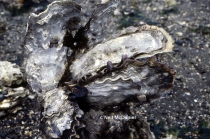WoRMS name details
Crassostrea gigas (Thunberg, 1793)
140656 (urn:lsid:marinespecies.org:taxname:140656)
unaccepted > superseded combination
Species
Crassostrea posjetica (Razin, 1934) · unaccepted > junior subjective synonym (synonym)
Dioeciostrea hispaniola Orton, 1928 · unaccepted (unavailable: journal disclaimer)
Lopha (Ostreola) posjetica (Razin, 1934) · unaccepted > junior subjective synonym
Lopha (Ostreola) posjetica var. beringi Vialov, 1946 · unaccepted > junior subjective synonym
Lopha (Ostreola) posjetica var. newelskyi Vialov, 1946 · unaccepted > junior subjective synonym
Lopha (Ostreola) posjetica var. zawoikoi Vialov, 1946 · unaccepted > junior subjective synonym
Ostraea cymbaeformis G. B. Sowerby II, 1871 · unaccepted (junior subjective synonym)
Ostraea rostralis Lamarck, 1819, sensu G. B. Sowerby II, 1871 · unaccepted (misapplication)
Ostrea chemnitzii var. elongata Grabau & S. G. King, 1928 · unaccepted (junior subjective synonym)
Ostrea gigas var. tientsiensis Grabau & S. G. King, 1928 · unaccepted (probable synonym)
Ostrea gravitesta Yokoyama, 1926 † · unaccepted (junior subjective synonym)
Ostrea laperousii Schrenck, 1861 · unaccepted (junior subjective synonym)
Ostrea posjetica Razin, 1934 · unaccepted (junior subjective synonym)
Ostrea talienwhanensis Crosse, 1862 · unaccepted (junior subjective synonym)
marine, fresh, terrestrial
recent + fossil
(of Ostrea gigas Thunberg, 1793) Thunberg, C.P. (1793). Tekning och Beskrifning på en stor Ostronsort ifrån Japan. <em>Kongliga Vetenskaps Academiens Nya Handlingar.</em> 14(4-6): 140-142, 1 pl., available online at https://www.biodiversitylibrary.org/page/46957303 [details] 
Taxonomy The Portuguese oyster Crassostrea angulata and the Japanese oyster Crassostrea gigas were described as distinct species...
Taxonomy The Portuguese oyster Crassostrea angulata and the Japanese oyster Crassostrea gigas were described as distinct species with widely separated geographical origins - southwestern Europe and Japan respectively. In the 1970's C. gigas was introduced to the Atlantic coast of France in order to restore oyster farming affected by a disease of C. angulata, and it became evident that the two species could hybridize (Menzel, 1974, Huvet et al., 2004) and therefore were treated as synonyms (Huber, 2010).
During the recent years, however, several genetic studies based on mitochondrial DNA and microsatellite data have provided evidence that the two taxa are genetically distinct although closely related (see overview in Batista et al. 2005). Particularly, an average of 2.3% difference in CO1 sequence suggests that populations of C. gigas and C. angulata may have diverged several hundred thousand years ago (Hedgecock et al., 2004). Studies involving microsatellite markers have shown that there are low but clear genetic differences between the two taxons. From all recent studies, it seems clear that the European C. angulata was introduced in the XVI or XVIIth century from Taiwan, and can be recognized genetically from C. gigas introduced later from Japan.
Nevertheless the relationship of both taxa in intermediate locations remains to be elucidated. Lapègue et al. (2004) reported characteristic haplotypes of both C. gigas and C. angulata occurred in a population from northern China locally known as C. talienwhanensis Crosse, 1862; this could either mean that both species are distinct but overlap ranges, or that all those haplotypes are to be found in a single, geographically variable species.
Considering this state of the art, C. angulata and C. gigas are listed here separately but qualified as very closely related and still possibly conspecific. [details]
During the recent years, however, several genetic studies based on mitochondrial DNA and microsatellite data have provided evidence that the two taxa are genetically distinct although closely related (see overview in Batista et al. 2005). Particularly, an average of 2.3% difference in CO1 sequence suggests that populations of C. gigas and C. angulata may have diverged several hundred thousand years ago (Hedgecock et al., 2004). Studies involving microsatellite markers have shown that there are low but clear genetic differences between the two taxons. From all recent studies, it seems clear that the European C. angulata was introduced in the XVI or XVIIth century from Taiwan, and can be recognized genetically from C. gigas introduced later from Japan.
Nevertheless the relationship of both taxa in intermediate locations remains to be elucidated. Lapègue et al. (2004) reported characteristic haplotypes of both C. gigas and C. angulata occurred in a population from northern China locally known as C. talienwhanensis Crosse, 1862; this could either mean that both species are distinct but overlap ranges, or that all those haplotypes are to be found in a single, geographically variable species.
Considering this state of the art, C. angulata and C. gigas are listed here separately but qualified as very closely related and still possibly conspecific. [details]
MolluscaBase eds. (2025). MolluscaBase. Crassostrea gigas (Thunberg, 1793). Accessed through: World Register of Marine Species at: https://www.marinespecies.org/aphia.php?p=taxdetails&id=140656 on 2025-07-06
Date
action
by
![]() The webpage text is licensed under a Creative Commons
Attribution 4.0 License
The webpage text is licensed under a Creative Commons
Attribution 4.0 License
Nomenclature
original description
(of Ostrea gigas Thunberg, 1793) Thunberg, C.P. (1793). Tekning och Beskrifning på en stor Ostronsort ifrån Japan. <em>Kongliga Vetenskaps Academiens Nya Handlingar.</em> 14(4-6): 140-142, 1 pl., available online at https://www.biodiversitylibrary.org/page/46957303 [details] 
basis of record Scarlato, O. A. (1981). Двустворчатые моллюски умеренных вод северо-западной части Тихого океана. Bivalve molluscs of the temperate latitudes of the western part of the Pacific Ocean. <em>Определители по фауне СССР. Guides to the fauna of the USSR.</em> 126: Nauka, Leningrad, 479 pp.
page(s): 253-254, photos 168-172 [details] Available for editors [request]
[request]
basis of record Scarlato, O. A. (1981). Двустворчатые моллюски умеренных вод северо-западной части Тихого океана. Bivalve molluscs of the temperate latitudes of the western part of the Pacific Ocean. <em>Определители по фауне СССР. Guides to the fauna of the USSR.</em> 126: Nauka, Leningrad, 479 pp.
page(s): 253-254, photos 168-172 [details] Available for editors
Taxonomy
redescription
Coan, E. V.; Valentich-Scott, P. (2012). Bivalve seashells of tropical West America. Marine bivalve mollusks from Baja California to northern Peru. 2 vols, 1258 pp. [details]
status source Bayne B.L., Ahrens M., Allen S. K., Anglès D'auriac M., Backeljau T., Beninger P., Bohn R., Boudry P., Davis J., Green T., Guo X., Hedgecock D., Ibarra A., Kingsley-Smith P., Krause M., Langdon C., Lapègue S., Li C., Manahan D., Mann R., Perez-Paralle L., Powell E.N., Rawson P.D., Speiser D., SanchezJ.L., Shumway S. & Wang H. (2017). The proposed dropping of the genus <i>Crassostrea</i> for all Pacific cupped oysters and Its replacement by a new genus <i>Magallana</i>: A dissenting view. <em>Journal of Shellfish Research.</em> 6(3): 545-547., available online at https://doi.org/10.2983/035.036.0301 [details]
status source Backeljau, T. (2018). Crassostrea gigas or Magallana gigas: A Community-based Scientific Response. <em>National Shellfisheries Association Quarterly Newsletter.</em> (1): 3., available online at https://shellfish.memberclicks.net/assets/docs/Current_Newsletters/qnl_2018_1.pdf [details]
status source Bayne B.L., Ahrens M., Allen S. K., Anglès D'auriac M., Backeljau T., Beninger P., Bohn R., Boudry P., Davis J., Green T., Guo X., Hedgecock D., Ibarra A., Kingsley-Smith P., Krause M., Langdon C., Lapègue S., Li C., Manahan D., Mann R., Perez-Paralle L., Powell E.N., Rawson P.D., Speiser D., SanchezJ.L., Shumway S. & Wang H. (2017). The proposed dropping of the genus <i>Crassostrea</i> for all Pacific cupped oysters and Its replacement by a new genus <i>Magallana</i>: A dissenting view. <em>Journal of Shellfish Research.</em> 6(3): 545-547., available online at https://doi.org/10.2983/035.036.0301 [details]
status source Backeljau, T. (2018). Crassostrea gigas or Magallana gigas: A Community-based Scientific Response. <em>National Shellfisheries Association Quarterly Newsletter.</em> (1): 3., available online at https://shellfish.memberclicks.net/assets/docs/Current_Newsletters/qnl_2018_1.pdf [details]
Other
additional source
Steyn, D.G. & Lussi, M. (1998) Marine Shells of South Africa. An Illustrated Collector's Guide to Beached Shells. Ekogilde Publishers, Hartebeespoort, South Africa, ii + 264 pp.
page(s): 208. [details]
additional source Huber, M. (2010). <i>Compendium of bivalves. A full-color guide to 3,300 of the world's marine bivalves. A status on Bivalvia after 250 years of research</i>. Hackenheim: ConchBooks. 901 pp., 1 CD-ROM. (look up in IMIS) [details]
additional source Huvet, A.; Fabioux, C.; Mccombie, H.; Lapegue, S.; Boudry, P. (2004). Natural hybridization between genetically differentiated populations of <i>Crassostrea gigas</i> and <i>C. angulata</i> highlighted by sequence variation in flanking regions of a microsatellite locus. <em>Marine Ecology Progress Series.</em> 272: 141-152., available online at http://archimer.ifremer.fr/doc/00000/3355/ [details]
additional source Hedgecock D., Li G., Hubert S., Bucklin K. & Ribes V. 2003. Widespread null alleles and poor cross-species amplification of microsatellite dna loci cloned from the Pacific oyster, <i>Crassostrea gigas</i>. <i>Journal of Shellfish Research</i>, 23(2): 379-385. , available online at http://biodiversitylibrary.org/page/3063290 [details]
additional source Yu Z., Kong X. Zhang L., Guo X. & Xiang J. 2003. Taxonomic status of four <i>Crassostrea</i> oysters from China as inferred from mitochondrial DNA sequences. <i>Journal of Shellfish Research</i>, 22(1): 31-38. , available online at http://biodiversitylibrary.org/page/3105572 [details]
additional source Marchini, A., J. Ferrario, A. Sfriso & A. Occhipinti-Ambrogi. (2015). Current status and trends of biological invasions in the Lagoon of Venice, a hotspot of marine NIS introductions in the Mediterranean Sea. <em>Biological Invasions.</em> 17:2943–2962., available online at https://doi.org/10.1007/s10530-015-0922-3 [details] Available for editors [request]
[request]
additional source Bayne, B.; Anglès d'Auriac, M.; Backeljau, T.; Beninger, P.; Boudry, P.; Carnegie, R.; Davis, J.; Guo, X.; Hedgecock, D.; Krause, M.; Langdon, C.; Lapègue, S.; Manahan, D.; Mann, R.; Powell, E.; Shumway, S. (2019). A scientific name for Pacific oysters. <em>Aquaculture.</em> 499: 373., available online at https://doi.org/10.1016/j.aquaculture.2018.08.048 [details]
additional source Branch, G.M., Griffiths, C.L., Branch, M.L. & Beckley, L.E. (2010). Two Oceans. A guide to the marine life of southern Africa. Revised edition. David Philip: Cape Town.
page(s): 150. [details]
additional source Valentich-Scott, P.; Coan, E. V.; Zelaya, D. (2020). <i>Bivalve seashells of western South America. Marine bivalve mollusks from Punta Aguja, Peru to Isla Chiloé, Chile</i>. Santa Barbara: Santa Barbara Museum of Natural History. vii + 593 pp.
page(s): 147, pl. 48 [details]
additional source Isaji, S.; Kato, H. (2011). A Fossil Pearl from the Upper Miocene Kubota Formation in the Higashitanagura Area, Fukushima Prefecture, Northeastern Japan. <em>Venus (Journal of the Malacological Society of Japan).</em> 69 (3-4): 195-201. [details] Available for editors [request]
[request]
page(s): 208. [details]
additional source Huber, M. (2010). <i>Compendium of bivalves. A full-color guide to 3,300 of the world's marine bivalves. A status on Bivalvia after 250 years of research</i>. Hackenheim: ConchBooks. 901 pp., 1 CD-ROM. (look up in IMIS) [details]
additional source Huvet, A.; Fabioux, C.; Mccombie, H.; Lapegue, S.; Boudry, P. (2004). Natural hybridization between genetically differentiated populations of <i>Crassostrea gigas</i> and <i>C. angulata</i> highlighted by sequence variation in flanking regions of a microsatellite locus. <em>Marine Ecology Progress Series.</em> 272: 141-152., available online at http://archimer.ifremer.fr/doc/00000/3355/ [details]
additional source Hedgecock D., Li G., Hubert S., Bucklin K. & Ribes V. 2003. Widespread null alleles and poor cross-species amplification of microsatellite dna loci cloned from the Pacific oyster, <i>Crassostrea gigas</i>. <i>Journal of Shellfish Research</i>, 23(2): 379-385. , available online at http://biodiversitylibrary.org/page/3063290 [details]
additional source Yu Z., Kong X. Zhang L., Guo X. & Xiang J. 2003. Taxonomic status of four <i>Crassostrea</i> oysters from China as inferred from mitochondrial DNA sequences. <i>Journal of Shellfish Research</i>, 22(1): 31-38. , available online at http://biodiversitylibrary.org/page/3105572 [details]
additional source Marchini, A., J. Ferrario, A. Sfriso & A. Occhipinti-Ambrogi. (2015). Current status and trends of biological invasions in the Lagoon of Venice, a hotspot of marine NIS introductions in the Mediterranean Sea. <em>Biological Invasions.</em> 17:2943–2962., available online at https://doi.org/10.1007/s10530-015-0922-3 [details] Available for editors
additional source Bayne, B.; Anglès d'Auriac, M.; Backeljau, T.; Beninger, P.; Boudry, P.; Carnegie, R.; Davis, J.; Guo, X.; Hedgecock, D.; Krause, M.; Langdon, C.; Lapègue, S.; Manahan, D.; Mann, R.; Powell, E.; Shumway, S. (2019). A scientific name for Pacific oysters. <em>Aquaculture.</em> 499: 373., available online at https://doi.org/10.1016/j.aquaculture.2018.08.048 [details]
additional source Branch, G.M., Griffiths, C.L., Branch, M.L. & Beckley, L.E. (2010). Two Oceans. A guide to the marine life of southern Africa. Revised edition. David Philip: Cape Town.
page(s): 150. [details]
additional source Valentich-Scott, P.; Coan, E. V.; Zelaya, D. (2020). <i>Bivalve seashells of western South America. Marine bivalve mollusks from Punta Aguja, Peru to Isla Chiloé, Chile</i>. Santa Barbara: Santa Barbara Museum of Natural History. vii + 593 pp.
page(s): 147, pl. 48 [details]
additional source Isaji, S.; Kato, H. (2011). A Fossil Pearl from the Upper Miocene Kubota Formation in the Higashitanagura Area, Fukushima Prefecture, Northeastern Japan. <em>Venus (Journal of the Malacological Society of Japan).</em> 69 (3-4): 195-201. [details] Available for editors
 Present
Present  Present in aphia/obis/gbif/idigbio
Present in aphia/obis/gbif/idigbio  Inaccurate
Inaccurate  Introduced: alien
Introduced: alien  Containing type locality
Containing type locality
From editor or global species database
Taxonomy The Portuguese oyster Crassostrea angulata and the Japanese oyster Crassostrea gigas were described as distinct species with widely separated geographical origins - southwestern Europe and Japan respectively. In the 1970's C. gigas was introduced to the Atlantic coast of France in order to restore oyster farming affected by a disease of C. angulata, and it became evident that the two species could hybridize (Menzel, 1974, Huvet et al., 2004) and therefore were treated as synonyms (Huber, 2010). During the recent years, however, several genetic studies based on mitochondrial DNA and microsatellite data have provided evidence that the two taxa are genetically distinct although closely related (see overview in Batista et al. 2005). Particularly, an average of 2.3% difference in CO1 sequence suggests that populations of C. gigas and C. angulata may have diverged several hundred thousand years ago (Hedgecock et al., 2004). Studies involving microsatellite markers have shown that there are low but clear genetic differences between the two taxons. From all recent studies, it seems clear that the European C. angulata was introduced in the XVI or XVIIth century from Taiwan, and can be recognized genetically from C. gigas introduced later from Japan.
Nevertheless the relationship of both taxa in intermediate locations remains to be elucidated. Lapègue et al. (2004) reported characteristic haplotypes of both C. gigas and C. angulata occurred in a population from northern China locally known as C. talienwhanensis Crosse, 1862; this could either mean that both species are distinct but overlap ranges, or that all those haplotypes are to be found in a single, geographically variable species.
Considering this state of the art, C. angulata and C. gigas are listed here separately but qualified as very closely related and still possibly conspecific. [details]
From regional or thematic species database
Introduced species abundance in Danish part of the Kattegat (Marine Region) : Common [details]Introduced species abundance in Danish part of the North Sea (Marine Region) : Common [details]
Introduced species abundance in Slovenian part of the Adriatic Sea (Marine Region) : Common [details]
Introduced species abundance in Danish part of the North Sea (Marine Region) : Common [details]
Introduced species abundance in Norwegian part of the North Sea (Marine Region) : Common [details]
Introduced species abundance in Swedish part of the Kattegat (Marine Region) : Common [details]
Introduced species impact Irish part of the Inner Seas off the West Coast of Scotland (Marine Region) Outcompetes native species for resources and/or space [details]
Introduced species impact Irish part of the Inner Seas off the West Coast of Scotland (Marine Region) Other impact - undefined or uncertain
Although there were consistent positive effects of C. gigas on mud-flat biodiversity, effects were weak or negative at higher cover on mussel-beds. [details]
Introduced species impact in Slovenian part of the Adriatic Sea (Marine Region) : Other impact - undefined or uncertain [details]
Introduced species impact in Australia (Nation) : Other impact - undefined or uncertain [details]
Introduced species impact in Belgian part of the North Sea : Other impact - undefined or uncertain [details]
Introduced species impact in Chile (Nation) : Other impact - undefined or uncertain [details]
Introduced species impact in France (Nation) : Other impact - undefined or uncertain [details]
Introduced species impact in Germany (Nation) : Other impact - undefined or uncertain [details]
Introduced species impact in United Kingdom (Nation) : Other impact - undefined or uncertain [details]
Introduced species impact in New Zealand (Nation) : Adverse habitat modification [details]
Introduced species impact in Mexico (Nation) : Damage to marine structures or archaeology [details]
Introduced species impact in France (Nation) : Water abstraction or nuisance fouling [details]
Introduced species impact in New Zealand (Nation) : Alters trophic interactions [details]
Introduced species impact in New Zealand (Nation) : Outcompetes native species for resources and/or space [details]
Introduced species impact in Danish part of the Kattegat (Marine Region) : Outcompetes native species for resources and/or space [details]
Introduced species impact in Danish part of the North Sea (Marine Region) : Outcompetes native species for resources and/or space [details]
Introduced species impact in Australia (Nation) : Other impact - undefined or uncertain [details]
Introduced species impact in North Atlantic Ocean (IHO Sea Area) : Other impact - undefined or uncertain [details]
Introduced species impact in Maltese part of the Mediterranean Sea - Eastern Basin : Loss of public/tourist amenity [details]
Introduced species impact in Danish part of the North Sea (Marine Region) : Outcompetes native species for resources and/or space [details]
Introduced species impact in Norwegian part of the North Sea (Marine Region) : Outcompetes native species for resources and/or space [details]
Introduced species impact in Swedish part of the Kattegat (Marine Region) : Outcompetes native species for resources and/or space [details]
Introduced species impact German part of the North Sea (Marine Region) Pathogen/parasite or carrier of a pathogen/parasite [details]
Introduced species impact Chinese part of the South China Sea (Marine Region) Pathogen/parasite or carrier of a pathogen/parasite [details]
Introduced species impact Chinese part of the Yellow Sea (Marine Region) Pathogen/parasite or carrier of a pathogen/parasite [details]
Introduced species impact Chinese part of the Eastern Chinese Sea(Marine Region) Pathogen/parasite or carrier of a pathogen/parasite [details]
Introduced species management in Australia (Nation) : yes [details]
Introduced species remark in Tunisian part of the Mediterranean Sea - Eastern Basin (Marine Region) : Populations were generally not self-sustained and succesful reproduction was only reported in 2002-2003 for the Bizerte Lagoon [details]
Introduced species remark in Tunisian part of the Mediterranean Sea - Eastern Basin (Marine Region) : Populations were generally not self-sustained. [details]
Introduced species remark in New Zealand (Nation) : Negatively affects native periwinkle growth, body weight and egg production. Slows down crawling speed, which decreases grazing success. [details]
Introduced species remark in Danish part of the Kattegat (Marine Region) : The species is considered adaptive & invasive & may compete with local bivalve species for space and food (Diederich 2006; Krassoi et al., 2008 in Wrange et al. 2009). Increased water temperatures over recent decades are believed to have facilitated expan [details]
Introduced species remark in Danish part of the North Sea (Marine Region) : The species is considered adaptive & invasive & may compete with local bivalve species for space and food (Diederich 2006; Krassoi et al., 2008 in Wrange et al. 2009). Increased water temperatures over recent decades are believed to have facilitated expan [details]
Introduced species remark In Tunisian part of the Mediterranean Sea - Eastern Basin (Marine Region) : Populations were generally not self-sustained [details]
Introduced species remark In Slovenian part of the Adriatic Sea (Marine Region) : Crocetta (2011) in Lipej et al. 2012 reported C. gigas from all over the Gulf of Trieste. It is now distributed across the Slovenian coast mainly in the lower mediolittoral belt (De Min & Vio, 1997 in Lipej et al. 2012) especially in canals of salinas. [details]
Introduced species remark In Danish part of the North Sea (Marine Region) : The species is considered adaptive & invasive & may compete with local bivalve species for space and food (Diederich 2006; Krassoi et al., 2008 in Wrange et al. 2009). Oyster biomass in the Danish Wadden Sea increased from 1056 to 6264 tonnes between 2005-2007. Increased water temperatures over recent decades are believed to have facilitated expansion of the species in Scandinavia. [details]
Introduced species remark In Norwegian part of the North Sea (Marine Region) : The species is considered adaptive & invasive & may compete with local bivalve species for space and food (Diederich 2006; Krassoi et al., 2008 in Wrange et al. 2009). Oyster biomass in the Danish Wadden Sea increased from 1056 to 6264 tonnes between 2005-2007. Increased water temperatures over recent decades are believed to have facilitated expansion of the species in Scandinavia. [details]
Introduced species remark In Swedish part of the Kattegat (Marine Region) : The species is considered adaptive & invasive & may compete with local bivalve species for space and food (Diederich 2006; Krassoi et al., 2008 in Wrange et al. 2009). Oyster biomass in the Danish Wadden Sea increased from 1056 to 6264 tonnes between 2005-2007. Increased water temperatures over recent decades are believed to have facilitated expansion of the species in Scandinavia. [details]
Introduced species vector dispersal Croatian part of the Adriatic Sea (Marine Region) Ships: general [details]
Introduced species vector dispersal United States part of the North Pacific Ocean (Marine Region) Aquaculuture: deliberate [details]
Introduced species vector dispersal in Tunisian part of the Mediterranean Sea - Eastern Basin (Marine Region) : Aquaculture: accidental [details]
Introduced species vector dispersal in France (Nation) : Aquaculture: deliberate [details]
Introduced species vector dispersal in Danish part of the Kattegat (Marine Region) : Aquaculture: deliberate [details]
Introduced species vector dispersal in Danish part of the Kattegat (Marine Region) : Since the introduction of this species for aquaculture many introduced stocks have established permanent & self sustaining populations in the wild [details]
Introduced species vector dispersal in Danish part of the North Sea (Marine Region) : Aquaculture: deliberate [details]
Introduced species vector dispersal in Danish part of the North Sea (Marine Region) : Since the introduction of this species for aquaculture many introduced stocks have established permanent & self sustaining populations in the wild [details]
Introduced species vector dispersal in Maltese part of the Mediterranean Sea - Eastern Basin (Marine Region) : Aquaculture: deliberate [details]
Introduced species vector dispersal in Tunisian part of the Mediterranean Sea - Eastern Basin (Marine Region) : Aquaculture: accidental [details]
Introduced species vector dispersal in Maltese part of the Mediterranean Sea - Eastern Basin : Aquaculture: deliberate [details]
Introduced species vector dispersal in Slovenian part of the Adriatic Sea (Marine Region) : Fisheries: deliberate translocations of fish or shellfish to establish or support fishery [details]
Introduced species vector dispersal in Danish part of the North Sea (Marine Region) : Aquaculture: deliberate
Since the introduction of this species for aquaculture many introduced stocks have established permanent & self sustaining populations in the wild [details]
Introduced species vector dispersal in Norwegian part of the North Sea (Marine Region) : Aquaculture: deliberate
Since the introduction of this species for aquaculture many introduced stocks have established permanent & self sustaining populations in the wild [details]
Introduced species vector dispersal in Swedish part of the Kattegat (Marine Region) : Aquaculture: deliberate
Since the introduction of this species for aquaculture many introduced stocks have established permanent & self sustaining populations in the wild [details]
Introduced species vector dispersal Chinese part of the Yellow Sea (Marine Region) Aquaculture [details]
Introduced species vector dispersal Chinese part of the Eastern Chinese Sea(Marine Region) Aquaculture [details]
Introduced species vector dispersal Chinese part of the South China Sea (Marine Region) Aquaculture [details]
Introduced species vector dispersal Australian part of the Tasman Sea (Marine Region) Aquaculture: deliberate [details]
Introduced species vector dispersal in France (Nation) : Aquaculture: deliberate [details]
Unreviewed
Alien species The Pacific cupped oyster Crassostrea gigas, seen by many people as a delicacy, was imported to Belgium in 1969 as an alternative to the failing farming of the local common oyster. It was originally thought that the species would not be able to reproduce here because of the cold climate. However, this proved to be incorrect. The Pacific cupped oyster is comfortable in Belgian waters and is able to attach itself to all kinds of hard substrates (dikes, groins, mussel banks…), while competing with mussels and other local shellfish for available space and food. [details]
| Language | Name | |
|---|---|---|
| Catalan | ostra japonesa | [details] |
| Dutch | Japanse oester | [details] |
| English | Portuguese oysterPacific oysterPacific giant oysterPacific cupped oysterJapanese oysterimmigrant oystergiant pacific oystergiant oystergiant cupped oyster | [details] |
| French | huître portugaisehuître japonaisehuître du Pacifiquehuître creuse japonaisehuître creuse du Pacifiquehuître creuse | [details] |
| German | RiesenausterPortugiesische AusterPazifische FelsenausterPazifische AusterJapanische AusterFelsenauster | [details] |
| Italian | ostrica giapponeseostrica del Pacificoostrica concava | [details] |
| Japanese | マガキ | [details] |
| Modern Greek (1453-) | Στρείδι Πορτογαλίας | [details] |
| Portuguese | ostra-gigante | [details] |
| Russian | Устрица тихоокеанская (гиганская) | [details] |
| Spanish | ostra japonesaostión del Pacíficoostión | [details] |
| Swedish | Japanskt jätteostron | [details] |
European Network on Invasive Alien Species (NOBANIS) - Crassostrea gigas
Global invasive species database - Crassostrea gigas
Marine Life Information Network - UK
To Biodiversity Heritage Library (102 publications)
To Biodiversity Heritage Library (2 publications) (from synonym Ostrea gravitesta Yokoyama, 1926 †)
To Biodiversity Heritage Library (3 publications) (from synonym Ostrea talienwhanensis Crosse, 1862)
To Biodiversity Heritage Library (4 publications) (from synonym Ostrea laperousii Schrenck, 1861)
To Biological Information System for Marine Life (BISMaL)
To Dyntaxa
To FAO Cultured Aquatic species fact sheets
To FAO Species fact sheets
To GenBank (296363 nucleotides; 65854 proteins)
To Global Biotic Interactions (GloBI)
To Global Invasive Species Database (GISD)
To Information system on Aquatic Non-Indigenous and Cryptogenic Species (AquaNIS)
To Marine Bivalves of the British Isles webpage at National Museum of Wales
To NHMUK collection (Ostrea talienwhanensis Crosse, 1862; SYNTYPES; NHMUK:ecatalogue:9257578) (from synonym Ostrea talienwhanensis Crosse, 1862)
To Niet-inheemse soorten Belgisch deel Noordzee en aanpalende estuaria (in Dutch)
To PESI
To PESI (from synonym Crassostrea posjetica (Razin, 1934))
To USNM Invertebrate Zoology Mollusca Collection
To ITIS
Global invasive species database - Crassostrea gigas
Marine Life Information Network - UK
To Biodiversity Heritage Library (102 publications)
To Biodiversity Heritage Library (2 publications) (from synonym Ostrea gravitesta Yokoyama, 1926 †)
To Biodiversity Heritage Library (3 publications) (from synonym Ostrea talienwhanensis Crosse, 1862)
To Biodiversity Heritage Library (4 publications) (from synonym Ostrea laperousii Schrenck, 1861)
To Biological Information System for Marine Life (BISMaL)
To Dyntaxa
To FAO Cultured Aquatic species fact sheets
To FAO Species fact sheets
To GenBank (296363 nucleotides; 65854 proteins)
To Global Biotic Interactions (GloBI)
To Global Invasive Species Database (GISD)
To Information system on Aquatic Non-Indigenous and Cryptogenic Species (AquaNIS)
To Marine Bivalves of the British Isles webpage at National Museum of Wales
To NHMUK collection (Ostrea talienwhanensis Crosse, 1862; SYNTYPES; NHMUK:ecatalogue:9257578) (from synonym Ostrea talienwhanensis Crosse, 1862)
To Niet-inheemse soorten Belgisch deel Noordzee en aanpalende estuaria (in Dutch)
To PESI
To PESI (from synonym Crassostrea posjetica (Razin, 1934))
To USNM Invertebrate Zoology Mollusca Collection
To ITIS


